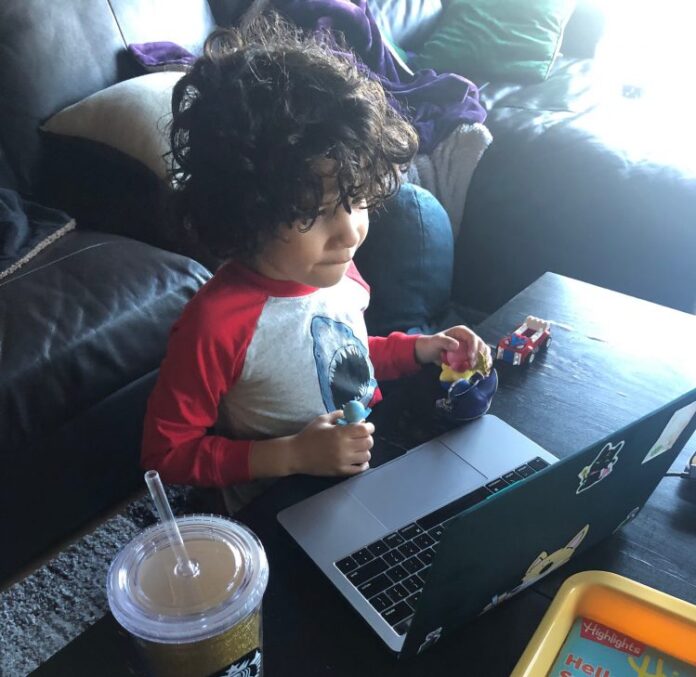By: Sarah McQuate
Published in the University of Washinton News
April 14, 2020
With thousands of schools and preschools closed and many states under “stay-at-home” orders to try to limit the spread of the novel coronavirus, families are facing a tough situation: trying to work — possibly remotely — while simultaneously being responsible for their children’s education.
University of Washington researchers are beginning a national study to help families discover technology that helps them both successfully navigate home-based learning and combat social isolation.
“I think some parents had idealized scenarios where they said ‘Oh, I’ll just put my kid in front of a computer for a few hours and while I work, they’ll do math and reading,’” said co-lead researcher Julie Kientz, a UW professor of human centered design and engineering. “It all sounded great, but then after one day it’s like, ‘Oh gosh, this is not going to work.’”
One major issue, the researchers said, is that it’s overwhelming trying to sort through seemingly endless technology options.
“People want to help parents manage this, and one easy way is to share resources. But in reality there are almost too many options,” Kientz said. “As a parent, I was added instantly to about five or six different Facebook groups all about trying to navigate this situation. Everyone was posting a million different resources, such as brightly colored schedules for homeschool.”
If you are interested in participating in this project, please fill out the team’s screener survey.
For their project, Kientz and team plan to recruit 30 diverse families with children ages 3 to 13 across the country. Participating families will be organized into three groups based on common family characteristics, such as children’s ages or work situations.
“We definitely want to include many different types of families, including parents who are still physically going to their jobs, parents who are in quarantine, intergenerational households and single parents,” Kientz said. “But we want to make sure the study itself isn’t creating more extra work for people who are already burdened.”
Each family is expected to participate for about 30 minutes a week during the 10-week study. Families will reflect on how the technology they use helps or hinders their lives.
“What we’re proposing to do here is find real stories from different types of families about what is helpful and what are the roadblocks,” Kientz said. “Then we plan to immediately share that information back out using social media and regular Medium posts. We’ll also provide a direct channel into some of the tools that support online learning, exercise and staying in touch at home.”
In the later part of the study, families will design new or redesign existing technologies — such as a new educational skill for Amazon Echo. Then the families will test simple prototypes of these designs. Most of these activities will be completed as a family, though there may be some caretaker- or child-only activities as well.
“It’s important to see things in terms of equity, too,” Kientz said. “Some people don’t have time to homeschool their kids, and a lot of these tools require high-speed internet access, iPads or other expensive equipment.”
The study will look at how families in different situations are finding tools that they are able to access and use successfully.
Kientz, who studies families and technology and is also the parent of two children ages 7 and 4, suggests the following reputable websites/apps:
- Learning
- Khan Academy (note: the iPad version, Khan Academy Kids, is easier for younger kids to navigate)
- Sesame Street
- ABCya
- Common Sense Media (and their remote-learning resource Wide Open School)
- Preschool-aged kids iPad apps like Sago World or any app by Toca Boca.
- Typing — Dance Mat Typing
- Coding — Code.org and Scratch/ScratchJr
- Staying connected with family and friends
- Minecraft (note: families could set up Realms to create a private server for their kids to socialize with their friends)
- Facebook’s Messenger Kids app
- FaceTime
- Exercise
- apps like Pokemon GO and Harry Potter Wizards Unite can make walks more entertaining (note: make sure you stay at least 6 feet away from others)
- Cosmic Kids Yoga
- Freeze Dance skill on Amazon Echo
- Just Dance for the Nintendo Switch
Additional co-lead researchers on this project are: Sean Munson, a UW associate professor of human centered design and engineering who has done similar research projects to study mental health and teens; Alexis Hiniker, a UW assistant professor in the Information School who studies families and technology; and Jason Yip, a UW assistant professor in the iSchool who works with children to design new technologies. Rebecca Michelson, a UW doctoral student in human centered design and engineering, is also a researcher on this project. This study is funded by the National Science Foundation.
For more information, contact Kientz at jkientz@uw.edu, Munson at smunson@uw.edu, Hiniker at alexisr@uw.edu and Yip at jcyip@uw.edu.
Grant number: 2027525
Source: https://www.washington.edu/news/2020/04/14/how-families-can-use-technology-to-juggle-childcare-and-remote-life/
Comment: This article points out ways kids and parents can use technology to aid in the work-from-home COVID days. I think it is an interesting example of how technology can be a good thing.




